Optimization Simulation and Comprehensive Evaluation Coupled with CNN-LSTM and PLUS for Multi-Scenario Land Use in Cultivated Land Reserve Resource Area
Abstract
1. Introduction
2. Materials and Methods
2.1. Study Area
2.2. Data Sources and Preprocessing
2.3. Methods
2.3.1. Land Use Change Simulation Based on CNN-LSTM and PLUS Models
2.3.2. Scenario Setting for Coupling the MOP Model with the Markov Chain
- (1)
- ESV and APB
- (2)
- Scenario setting for the development and utilization of saline–alkali land in the region
2.3.3. Multi-Scenario Land Use Change Carbon Balance Analysis
3. Results
3.1. Multi-Scenario Land Use Simulation Analysis in 2030
3.1.1. Accuracy Analysis of CNN-LSTM and PLUS Coupled Models
3.1.2. Multi-Scenario Land Use Simulation Results and Analysis for 2030
3.2. Land Use Change and Impact Assessment in Different Scenarios
3.2.1. Analysis of Land Use Change from 2020 to 2030
3.2.2. Assessment of Land Use Change Effects
3.3. The Impact of Land Use on CB in Different Scenarios
3.3.1. Analysis of CE and CS in Different Scenarios
3.3.2. Regional CB Change Trends Under Different Policy Orientations
4. Discussion
4.1. Analysis of the Contribution of Driving Factors
4.2. General Applicability and Limitations of Coupling CNN-LSTM with PLUS to Simulate Land Use Change
4.3. Evaluation of Land Use Effects Under Multi-Scenario Simulation
4.4. Policy Recommendations
- (1)
- Policies conducive to sustainable development
- (2)
- Tradeoff between environmental protection and low CEs
4.5. Prospects
5. Conclusions
- (1)
- Coupling the CNN-LSTM and PLUS models, the spatial distribution characteristics and dynamic change process of land use change could be effectively captured, and the Kappa of the simulation result was 0.8119. In the model, the feature extraction capability of the CNN-LSTM model for driving factors was combined with the spatial optimization function of PLUS. An innovative and efficient technical path was provided for multi-scenario land use simulation in cultivated land reserve resource areas.
- (2)
- There was a significant tradeoff between ESV and APB in the simulation of regional land use change under different policy orientations. In the EP scenario, which aims to maximize the value of ecosystem services, ESV increased by 4.36%, but APB increased by a lower rate of 7.33%. In the LC scenario, the expansion of cultivated land was prioritized, and APB increases by 22.11%, but the value of ecological services decreases by 3.44%. In the SD scenario, a dynamic balance was achieved between ESV and APB, and both ecological and economic benefits were optimized, providing a reference for the coordinated development of regional land resources.
- (3)
- Significant differences in carbon reduction potential were revealed to show the impact of different policy directions on the CB of the study area. The EP scenario had the lowest CB, only 1.4935 million tons, reducing CE by increasing the area of ecological land, but with limited increases in CS. The HD scenario was a CB of only 3.7931 million tons, indicating that the natural development model was unable to optimize regional CB. In the LC scenario, although CE was reduced by increasing the area of cultivated land, the increase in CS was limited, so the performance of CB was weakened. The SD scenario, with the highest CB, shows significant potential for balancing carbon reduction and agricultural development and is the optimal path for achieving sustainable use of regional land resources.
Author Contributions
Funding
Data Availability Statement
Acknowledgments
Conflicts of Interest
References
- Kavian, A.; Golshan, M.; Abdollahi, Z. Flow discharge simulation based on land use change predictions. Environ. Earth Sci. 2017, 76, 588. [Google Scholar] [CrossRef]
- Xu, Q.; Zhu, A.; Liu, J. Land-use change modeling with cellular automata using land natural evolution unit. Catena 2023, 224, 106998. [Google Scholar] [CrossRef]
- Wang, S.; Zheng, X. Dominant transition probability: Combining CA-Markov model to simulate land use change. Environ. Dev. Sustain. 2023, 25, 6829–6847. [Google Scholar] [CrossRef]
- Dou, Y.; Millington, J.D.A.; Bicudo Da Silva, R.F.; McCord, P.; Vina, A.; Song, Q.; Yu, Q.; Wu, W.; Batistella, M.; Moran, E.; et al. Land-use changes across distant places: Design of a telecoupled agent-based model. J. Land Use Sci. 2019, 14, 191–209. [Google Scholar] [CrossRef]
- Ward, D.P.; Murray, A.T.; Phinn, S.R. A stochastically constrained cellular model of urban growth. Comput. Environ. Urban Syst. 2000, 24, 539–558. [Google Scholar] [CrossRef]
- Guo, R.; Bai, Y. Simulation of an Urban-Rural Spatial Structure on the Basis of Green Infrastructure Assessment: The Case of Harbin, China. Land 2019, 8, 196. [Google Scholar] [CrossRef]
- Chotchaiwong, P.; Wijitkosum, S. Predicting Urban Expansion and Urban Land Use Changes in Nakhon Ratchasima City Using a CA-Markov Model under Two Different Scenarios. Land 2019, 8, 140. [Google Scholar] [CrossRef]
- Zhai, Y.; Yao, Y.; Guan, Q.; Liang, X.; Li, X.; Pan, Y.; Yue, H.; Yuan, Z.; Zhou, J. Simulating urban land use change by integrating a convolutional neural network with vector-based cellular automata. Geogr. Inf. Syst. 2020, 34, 1475–1499. [Google Scholar] [CrossRef]
- Liu, X.; Liang, X.; Li, X.; Xu, X.; Ou, J.; Chen, Y.; Li, S.; Wang, S.; Pei, F. A future land use simulation model (FLUS) for simulating multiple land use scenarios by coupling human and natural effects. Landsc. Urban Plan. 2017, 168, 94–116. [Google Scholar] [CrossRef]
- Liang, X.; Liu, X.; Li, X.; Chen, Y.; Tian, H.; Yao, Y. Delineating multi-scenario urban growth boundaries with a CA-based FLUS model and morphological method. Landsc. Urban Plan. 2018, 177, 47–63. [Google Scholar] [CrossRef]
- Liang, X.; Tian, H.; Li, X.; Huang, J.; Clarke, K.C.; Yao, Y.; Guan, Q.; Hu, G. Modeling the dynamics and walking accessibility of urban open spaces under various policy scenarios. Landsc. Urban Plan. 2021, 207, 103993. [Google Scholar] [CrossRef]
- Liang, X.; Guan, Q.; Clarke, K.C.; Liu, S.; Wang, B.; Yao, Y. Understanding the drivers of sustainable land expansion using a patch-generating land use simulation (PLUS) model: A case study in Wuhan, China. Comput. Environ. Urban Syst. 2021, 85, 101569. [Google Scholar] [CrossRef]
- Liang, X.; Guan, Q.; Clarke, K.C.; Chen, G.; Guo, S.; Yao, Y. Mixed-cell cellular automata: A new approach for simulating the spatio-temporal dynamics of mixed land use structures. Landsc. Urban Plan. 2021, 205, 103960. [Google Scholar] [CrossRef]
- Hochreiter, S.; Schmidhuber, J. Long short-term memory. Neural Comput. 1997, 9, 1735–1780. [Google Scholar] [CrossRef]
- Zhao, X.; Wang, P.; Gao, S.; Yasir, M.; Islam, Q.U. Combining LSTM and PLUS Models to Predict Future Urban Land Use and Land Cover Change: A Case in Dongying City, China. Remote Sens. 2023, 15, 2370. [Google Scholar] [CrossRef]
- Xu, X.; Kong, W.; Wang, L.; Wang, T.; Luo, P.; Cui, J. A novel and dynamic land use/cover change research framework based on an improved PLUS model and a fuzzy multiobjective programming model. Ecol. Inf. 2024, 80, 102460. [Google Scholar] [CrossRef]
- Liu, M.; Chen, H.; Qi, L.; Chen, C. LUCC Simulation Based on RF-CNN-LSTM-CA Model with High-Quality Seed Selection Iterative Algorithm. Appl. Sci. 2023, 13, 3407. [Google Scholar] [CrossRef]
- Huang, C.; Zhou, Y.; Wu, T.; Zhang, M.; Qiu, Y. A cellular automata model coupled with partitioning CNN-LSTM and PLUS models for urban land change simulation. J. Environ. Manag. 2024, 351, 119828. [Google Scholar] [CrossRef]
- Fan, X.; Cheng, Y.; Li, Y. Multi-Scenario Land Use Simulation and Land Use Conflict Assessment Based on the CLUMondo Model: A Case Study of Liyang, China. Land 2023, 12, 917. [Google Scholar] [CrossRef]
- Yang, Y.; Bao, W.; Liu, Y. Scenario simulation of land system change in the Beijing-Tianjin-Hebei region. Land Use Policy 2020, 96, 104677. [Google Scholar] [CrossRef]
- Wu, Z.; Zhou, L.; Wang, Y. Prediction of the Spatial Pattern of Carbon Emissions Based on Simulation of Land Use Change under Different Scenarios. Land 2022, 11, 1788. [Google Scholar] [CrossRef]
- Tang, W.; Cui, L.; Zheng, S.; Hu, W. Multi-Scenario Simulation of Land Use Carbon Emissions from Energy Consumption in Shenzhen, China. Land 2022, 11, 1673. [Google Scholar] [CrossRef]
- Li, Y.; Liu, X.; Wang, Y.; He, Z. Simulating multiple scenarios of land use/cover change using a coupled model to capture ecological and economic effects. Land Degrad. Dev. 2023, 34, 2862–2879. [Google Scholar] [CrossRef]
- Wang, H.; Zhang, C.; Yao, X.; Yun, W.; Ma, J.; Gao, L.; Li, P. Scenario simulation of the tradeoff between ecological land and farmland in black soil region of Northeast China. Land Use Policy 2022, 114, 105991. [Google Scholar] [CrossRef]
- Zou, L.; Liu, Y.; Wang, J.; Yang, Y.; Wang, Y. Land use conflict identification and sustainable development scenario simulation on China’s southeast coast. J. Clean. Prod. 2019, 238, 117899. [Google Scholar] [CrossRef]
- Wu, H.; Li, Z.; Clarke, K.C.; Shi, W.; Fang, L.; Lin, A.; Zhou, J. Examining the sensitivity of spatial scale in cellular automata Markov chain simulation of land use change. Geogr. Inf. Syst. 2019, 33, 1040–1061. [Google Scholar] [CrossRef]
- Arora, A.; Pandey, M.; Mishra, V.N.; Kumar, R.; Rai, P.K.; Costache, R.; Punia, M.; Di, L. Comparative evaluation of geospatial scenario-based land change simulation models using landscape metrics. Ecol. Indic. 2021, 128, 107810. [Google Scholar] [CrossRef]
- He, S.; Wang, D.; Zhao, P.; Chen, W.; Li, Y.; Chen, X.; Jamali, A.A. Dynamic simulation of debris flow waste-shoal land use based on an integrated system dynamics-geographic information systems model. Land Degrad. Dev. 2022, 33, 2062–2075. [Google Scholar] [CrossRef]
- Xiong, Y.; Chen, Y.; Peng, F.; Li, J.; Yan, X. Analog simulation of urban construction land supply and demand in Chang-Zhu-Tan Urban Agglomeration based on land intensive use. J. Geogr. Sci. 2019, 29, 1346–1362. [Google Scholar] [CrossRef]
- Zhang, P.; Liu, L.; Yang, L.; Zhao, J.; Li, Y.; Qi, Y.; Ma, X.; Cao, L. Exploring the response of ecosystem service value to land use changes under multiple scenarios coupling a mixed-cell cellular automata model and system dynamics model in Xi’an, China. Ecol. Indic. 2023, 147, 110009. [Google Scholar] [CrossRef]
- Shi, Q.; Gu, C.; Xiao, C. Multiple scenarios analysis on land use simulation by coupling socioeconomic and ecological sustainability in Shanghai, China. Sustain. Cities Soc. 2023, 95, 104578. [Google Scholar] [CrossRef]
- Guo, P.; Wang, H.; Qin, F.; Miao, C.; Zhang, F. Coupled MOP and PLUS-SA Model Research on Land Use Scenario Simulations in Zhengzhou Metropolitan Area, Central China. Remote Sens. 2023, 15, 3762. [Google Scholar] [CrossRef]
- Luo, P.; Wang, X.; Zhang, L.; Mohd Arif Zainol, M.R.R.; Duan, W.; Hu, M.; Guo, B.; Zhang, Y.; Wang, Y.; Nover, D. Future Land Use and Flood Risk Assessment in the Guanzhong Plain, China: Scenario Analysis and the Impact of Climate Change. Remote Sens. 2023, 15, 5778. [Google Scholar] [CrossRef]
- Wei, H.; Han, Q.; Ma, Y.; Ji, W.; Fan, W.; Liu, M.; Huang, J.; Li, L. Multi-Scenario Simulating the Effects of Land Use Change on Ecosystem Health for Rural Ecological Management in the Zheng-Bian-Luo Rural Area, Central China. Land 2024, 13, 1788. [Google Scholar] [CrossRef]
- Liu, J.; Xiao, B.; Jiao, J.; Li, Y.; Wang, X. Modeling the response of ecological service value to land use change through deep learning simulation in Lanzhou, China. Sci. Total Environ. 2021, 796, 148981. [Google Scholar] [CrossRef]
- Robert, C.; Ralph, D.; Rudolf, D.G.; Stephen, F.; Monica, G.; Bruce, H.; Karin, L.; Shahid, N.; Robert, V.O.; Jose, P.; et al. The value of the world’s ecosystem services and natural capital. Nature 1997, 387, 253–260. [Google Scholar]
- Liu, Z. Rural land sustainability development planning and use by considering land multifunction values: A case study of analysis and simulation. Land Use Policy 2025, 150, 107455. [Google Scholar] [CrossRef]
- Li, L.; Huang, X.; Yang, H. Optimizing land use patterns to improve the contribution of land use planning to carbon neutrality target. Land Use Policy 2023, 135, 135635. [Google Scholar] [CrossRef]
- Chuai, X.; Huang, X.; Lu, Q.; Zhang, M.; Zhao, R.; Lu, J. Spatiotemporal Changes of Built-Up Land Expansion and Carbon Emissions Caused by the Chinese Construction Industry. Environ. Sci. Technol. 2015, 49, 13021–13030. [Google Scholar] [CrossRef]
- Chuai, X.; Huang, X.; Lai, L.; Wang, W.; Peng, J.; Zhao, R. Land use structure optimization based on carbon storage in several regional terrestrial ecosystems across China. Environ. Sci. Policy 2013, 25, 50–61. [Google Scholar] [CrossRef]
- Wang, C.; Zhan, J.; Zhang, F.; Liu, W.; Twumasi-Ankrah, M.J. Analysis of urban carbon balance based on land use dynamics in the Beijing-Tianjin-Hebei region, China. J. Clean. Prod. 2021, 281, 125138. [Google Scholar] [CrossRef]
- Wang, C.; Li, T.; Guo, X.; Xia, L.; Lu, C.; Wang, C. Plus-InVEST Study of the Chengdu-Chongqing Urban Agglomeration’s Land-Use Change and Carbon Storage. Land 2022, 11, 1617. [Google Scholar] [CrossRef]
- Kou, J.; Wang, J.; Ding, J.; Ge, X. Spatial Simulation and Prediction of Land Use/Land Cover in the Transnational Ili-Balkhash Basin. Remote Sens. 2023, 15, 3059. [Google Scholar] [CrossRef]
- Wang, Z.; Li, X.; Mao, Y.; Li, L.; Wang, X.; Lin, Q. Dynamic simulation of land use change and assessment of carbon storage based on climate change scenarios at the city level: A case study of Bortala, China. Ecol. Indic. 2022, 134, 108499. [Google Scholar] [CrossRef]
- Li, Q.; Wang, L.; Gul, H.N.; Li, D. Simulation and optimization of land use pattern to embed ecological suitability in an oasis region: A case study of Ganzhou district, Gansu province, China. J. Environ. Manag. 2021, 287, 112321. [Google Scholar] [CrossRef]
- Zhang, H.; Liao, X.; Zhai, T. Evaluation of ecosystem service based on scenario simulation of land use in Yunnan Province. Phys. Chem. Earth 2018, 104, 58–65. [Google Scholar] [CrossRef]
- Nasiakou, S.; Vrahnakis, M.; Chouvardas, D.; Mamanis, G.; Kleftoyanni, V. Land Use Changes for Investments in Silvoarable Agriculture Projected by the CLUE-S Spatio-Temporal Model. Land 2022, 11, 598. [Google Scholar] [CrossRef]
- Penny, J.; Djordjevic, S.; Chen, A.S. Using public participation within land use change scenarios for analysing environmental and socioeconomic drivers. Environ. Res. Lett. 2022, 17, 025002. [Google Scholar] [CrossRef]
- Pradhan, S.; Dhar, A.; Tiwari, K.N.; Sahoo, S. Spatiotemporal analysis of land use land cover and future simulation for agricultural sustainability in a sub-tropical region of India. Environ. Dev. Sustain. 2023, 25, 7873–7902. [Google Scholar] [CrossRef]
- Sahoo, S.; Sil, I.; Dhar, A.; Debsarkar, A.; Das, P.; Kar, A. Future scenarios of land-use suitability modeling for agricultural sustainability in a river basin. J. Clean. Prod. 2018, 205, 313–328. [Google Scholar] [CrossRef]
- Tang, H.; Halike, A.; Yao, K.; Wei, Q.; Yao, L.; Tuheti, B.; Luo, J.; Duan, Y. Ecosystem service valuation and multi-scenario simulation in the Ebinur Lake Basin using a coupled GMOP-PLUS model. Sci. Rep. 2024, 14, 5071. [Google Scholar] [CrossRef] [PubMed]
- Li, C.; Wu, Y.; Gao, B.; Zheng, K.; Wu, Y.; Li, C. Multi-scenario simulation of ecosystem service value for optimization of land use in the Sichuan-Yunnan ecological barrier, China. Ecol. Indic. 2021, 132, 108328. [Google Scholar] [CrossRef]
- Ma, X.; Li, J.; Li, G. Simulation and multi-scenario prediction of land-use change in the Gansu section of the Yellow River Basin, China. Front. Environ. Sci. 2024, 12, 1403248. [Google Scholar] [CrossRef]
- Lou, Y.; Yang, D.; Zhang, P.; Zhang, Y.; Song, M.; Huang, Y.; Jing, W. Multi-Scenario Simulation of Land Use Changes with Ecosystem Service Value in the Yellow River Basin. Land 2022, 11, 992. [Google Scholar] [CrossRef]
- Wei, X.; Zhang, S.; Luo, P.; Zhang, S.; Wang, H.; Kong, D.; Zhang, Y.; Tang, Y.; Sun, S. A Multi-Scenario Prediction and Spatiotemporal Analysis of the Land Use and Carbon Storage Response in Shaanxi. Remote Sens. 2023, 15, 5036. [Google Scholar] [CrossRef]
- Gong, W.; Duan, X.; Sun, Y.; Zhang, Y.; Ji, P.; Tong, X.; Qiu, Z.; Liu, T. Multi-scenario simulation of land use/cover change and carbon storage assessment in Hainan coastal zone from perspective of free trade port construction. J. Clean. Prod. 2023, 385, 135630. [Google Scholar] [CrossRef]
- Li, Y.; Liu, Z.; Li, S.; Li, X. Multi-Scenario Simulation Analysis of Land Use and Carbon Storage Changes in Changchun City Based on FLUS and InVEST Model. Land 2022, 11, 647. [Google Scholar] [CrossRef]
- Ma, S.; Huang, J.; Wang, X.; Fu, Y. Multi-scenario simulation of low-carbon land use based on the SD-FLUS model in Changsha, China. Land Use Policy 2025, 148, 107418. [Google Scholar] [CrossRef]
- Gong, P.; Li, X.; Wang, J.; Bai, Y.; Cheng, B.; Hu, T.; Liu, X.; Xu, B.; Yang, J.; Zhang, W.; et al. Annual maps of global artificial impervious area (GAIA) between 1985 and 2018. Remote Sens. Environ. 2020, 236, 111510. [Google Scholar] [CrossRef]
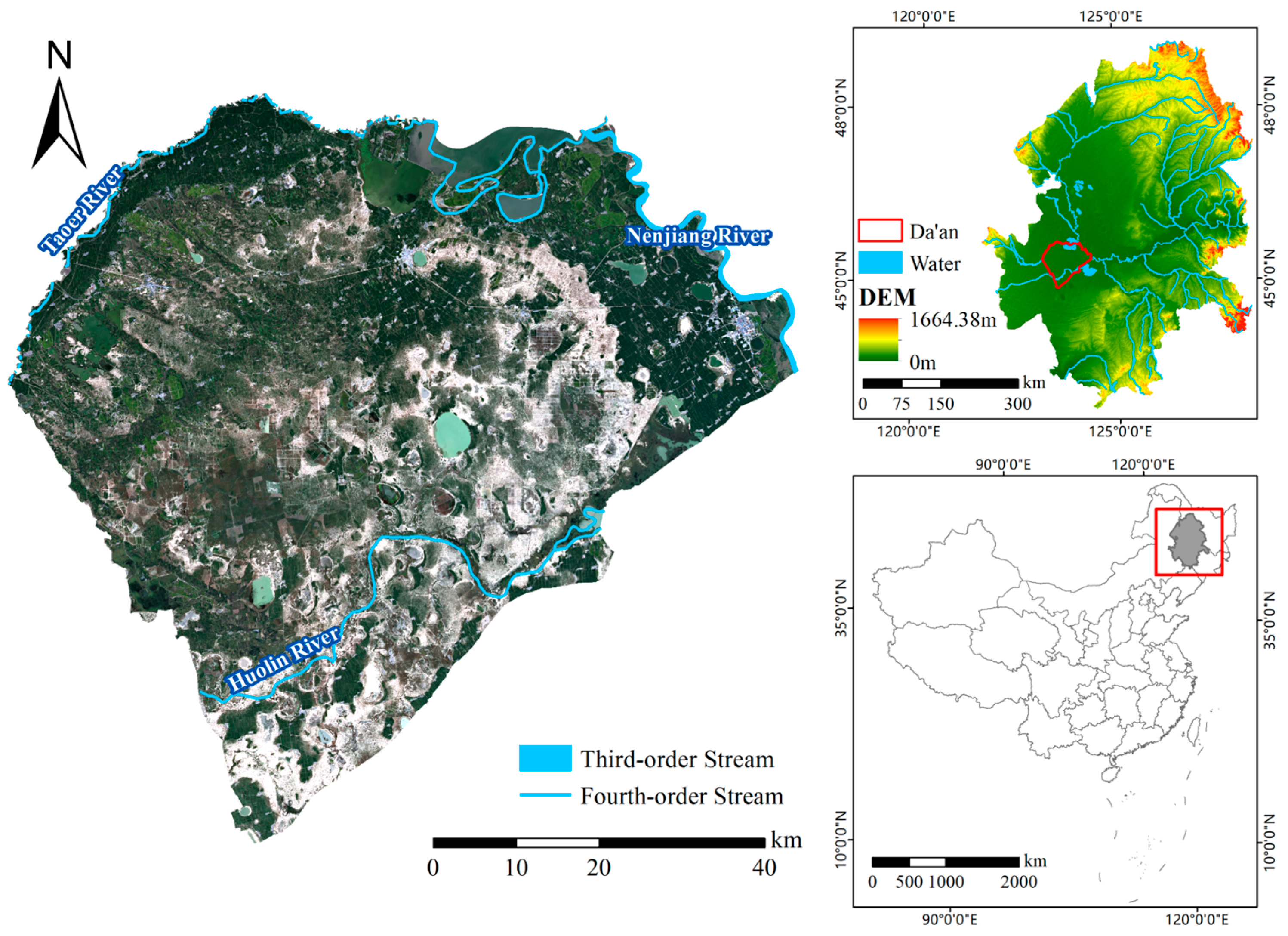
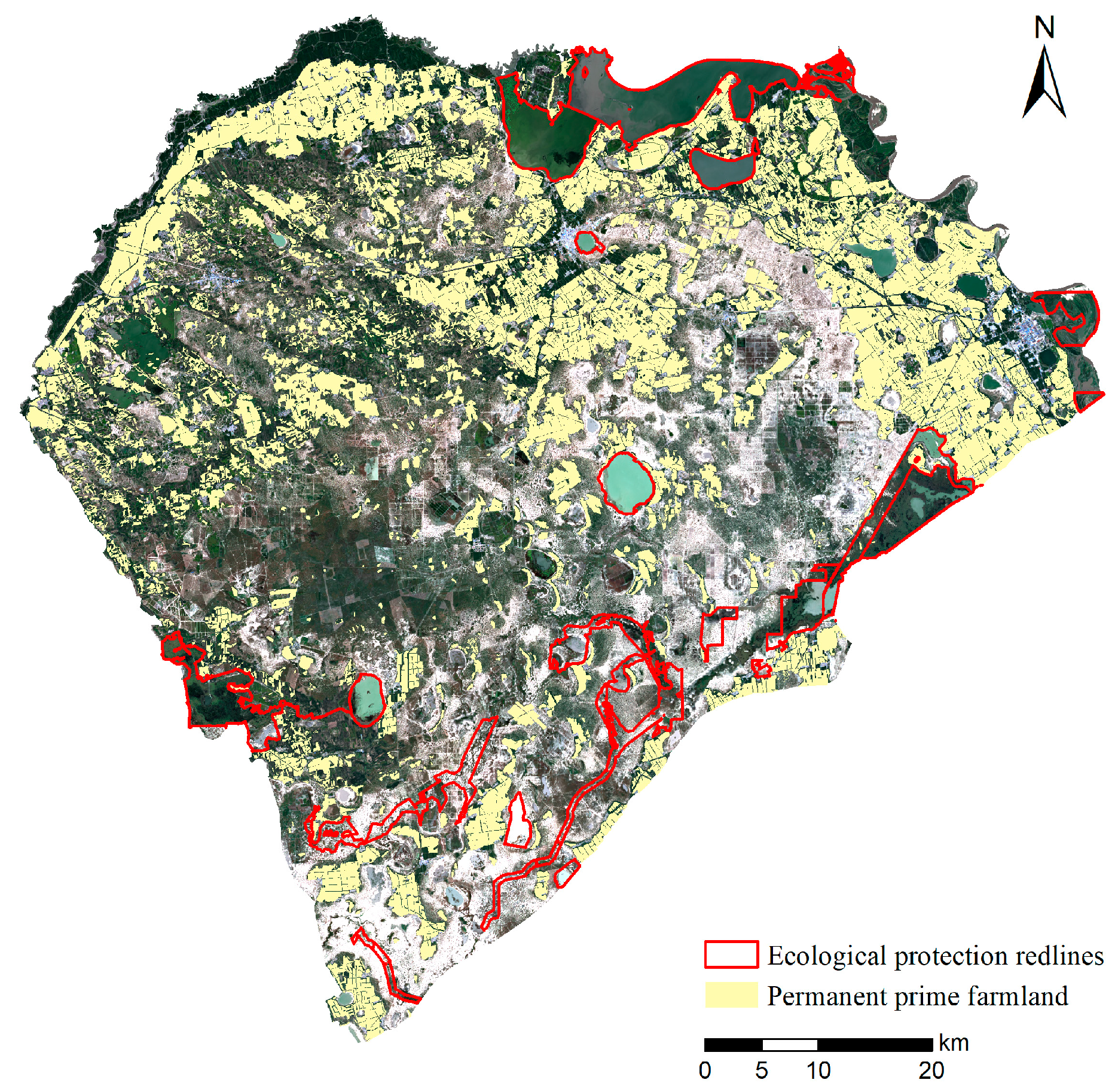
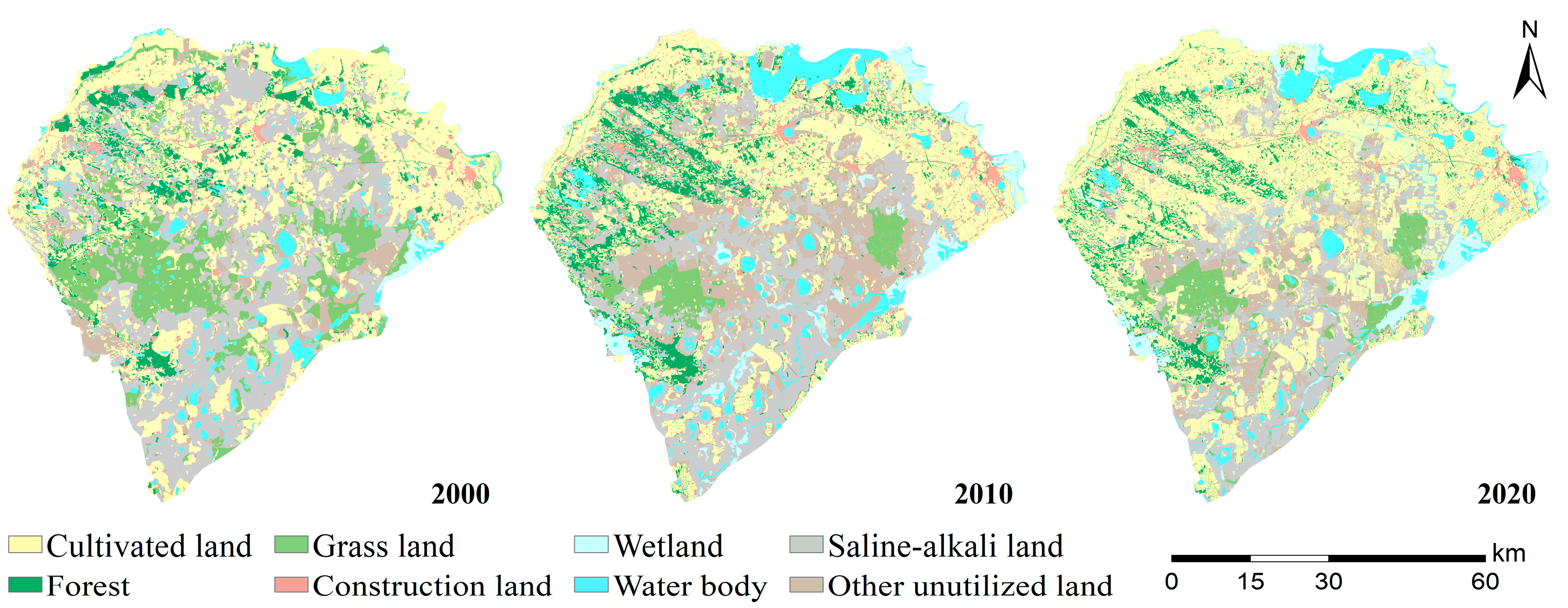
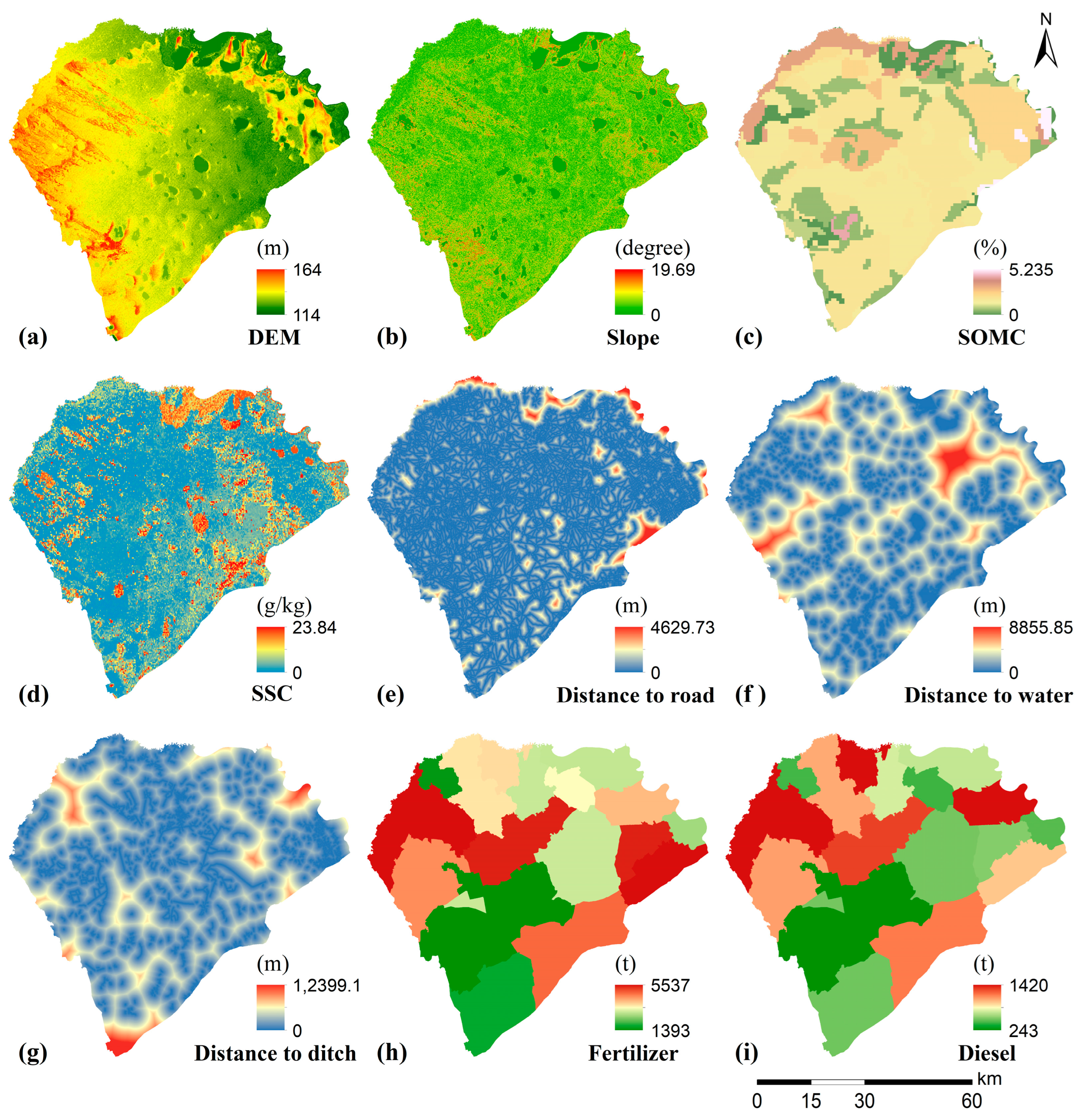
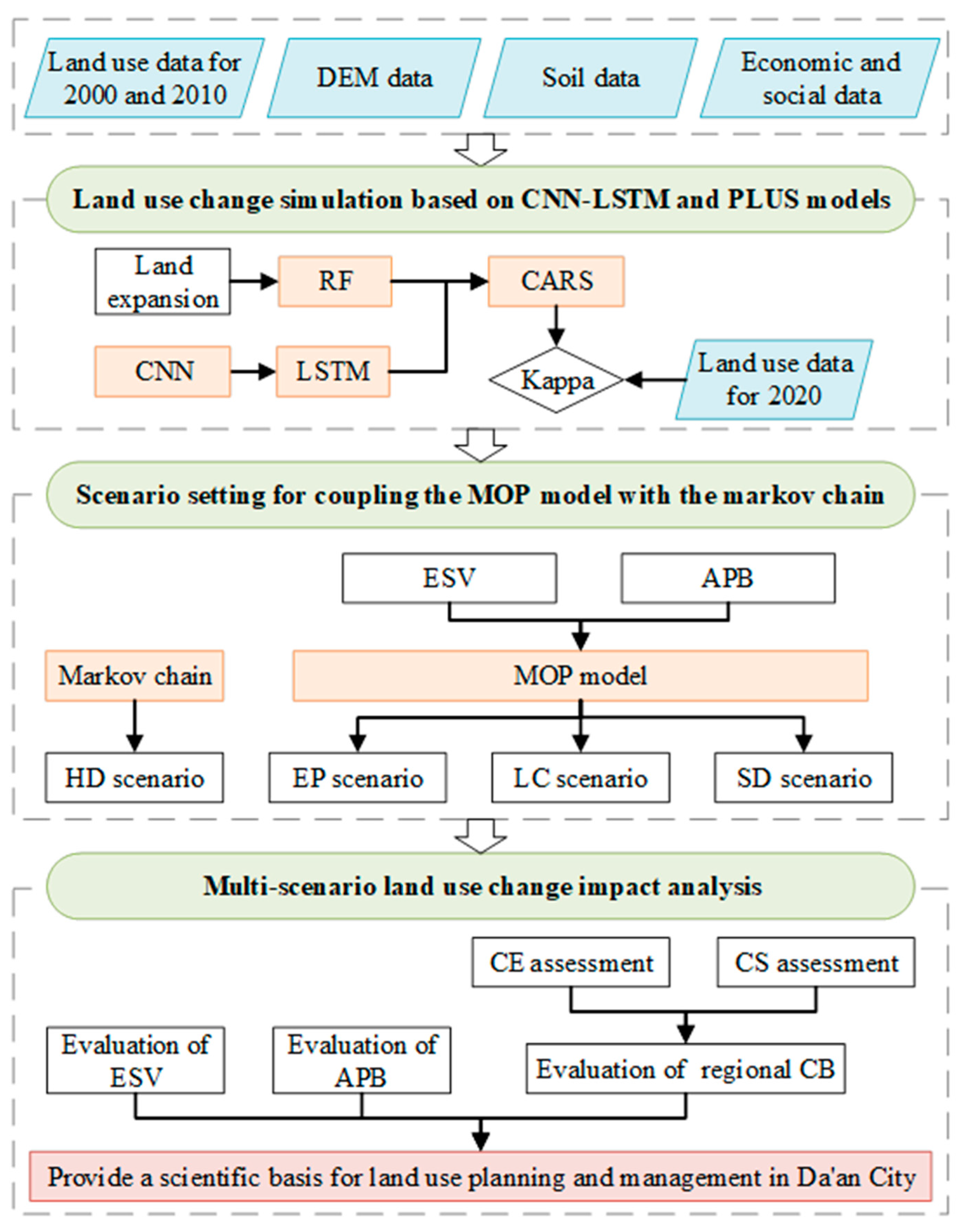
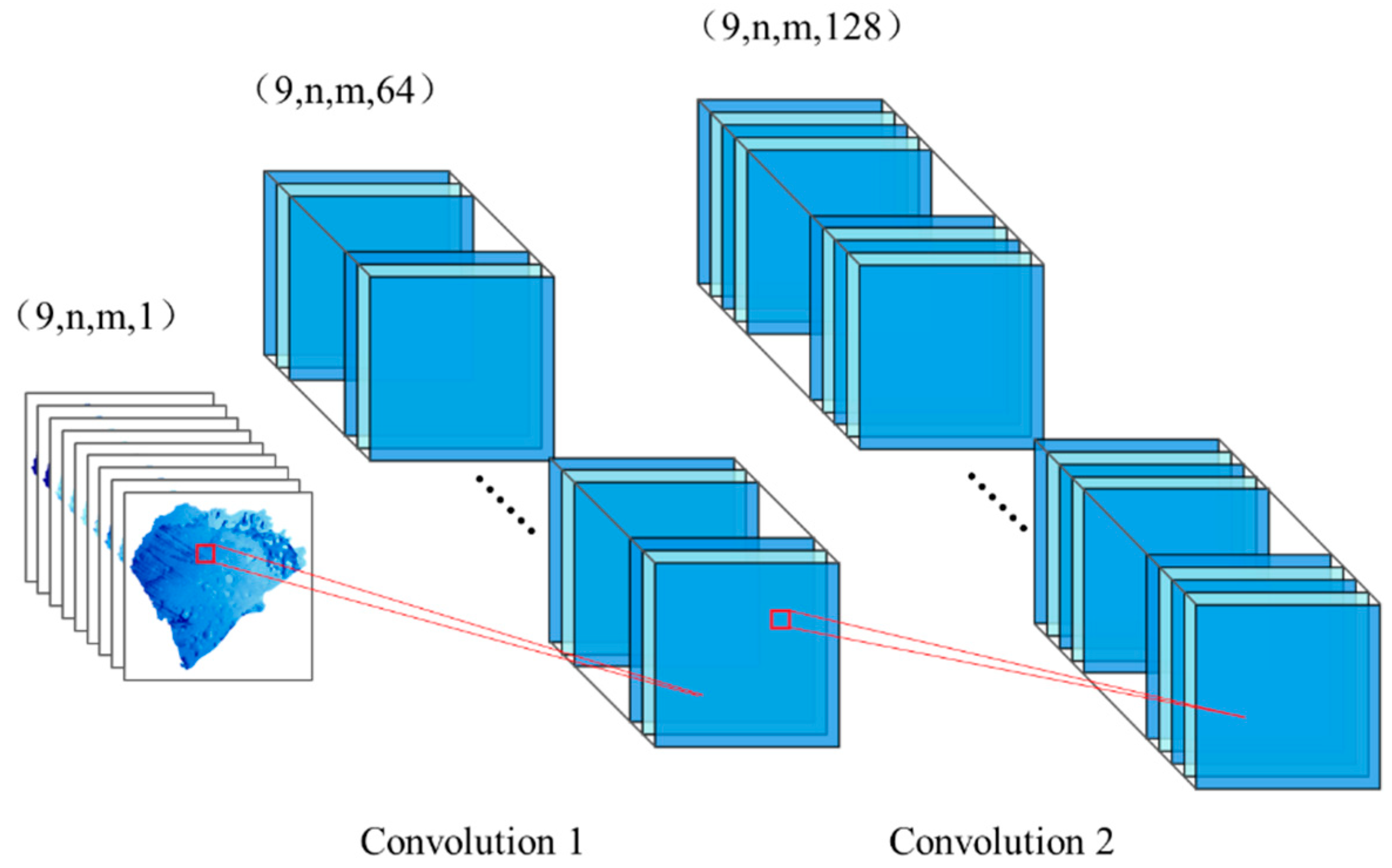
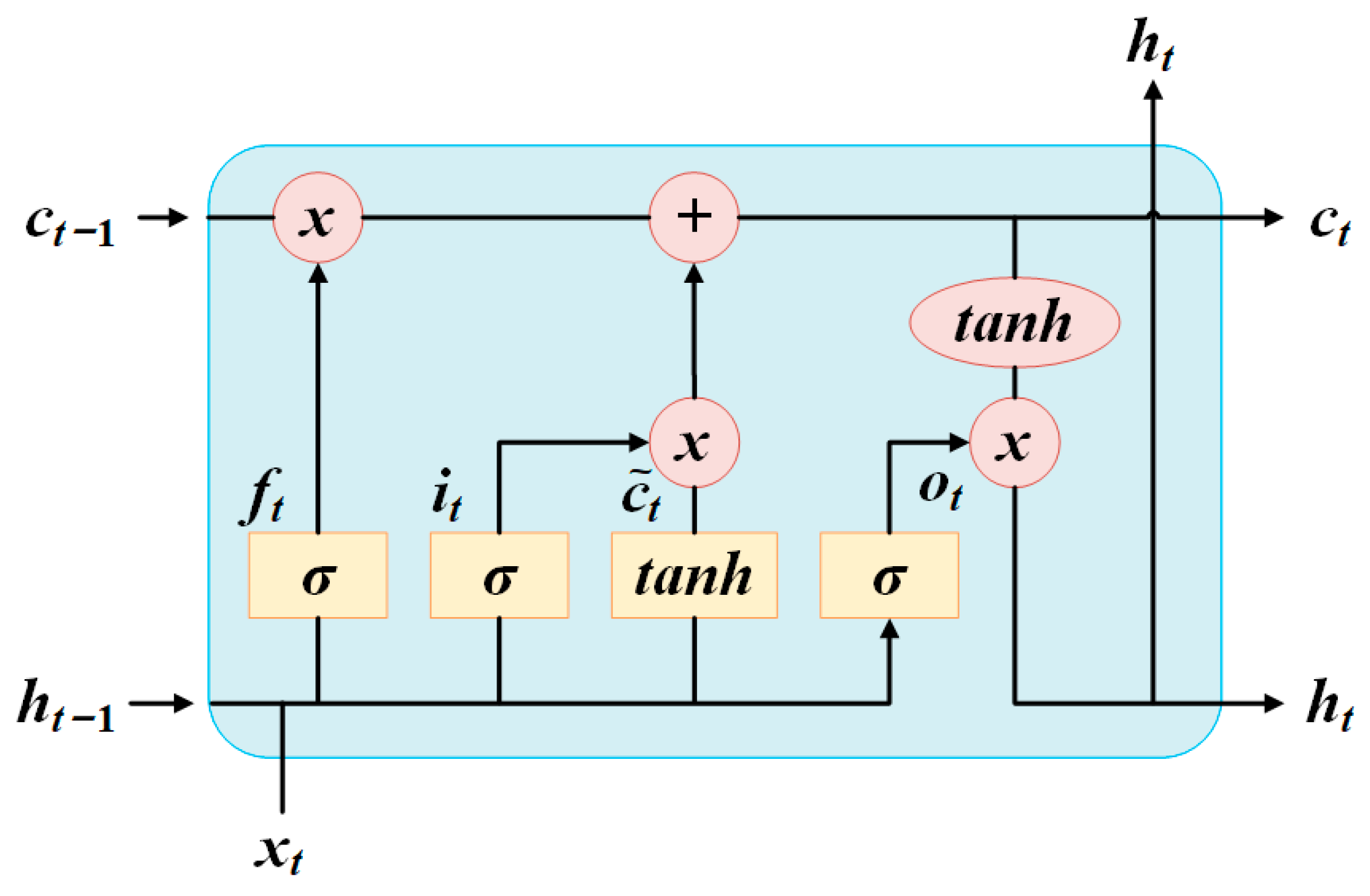
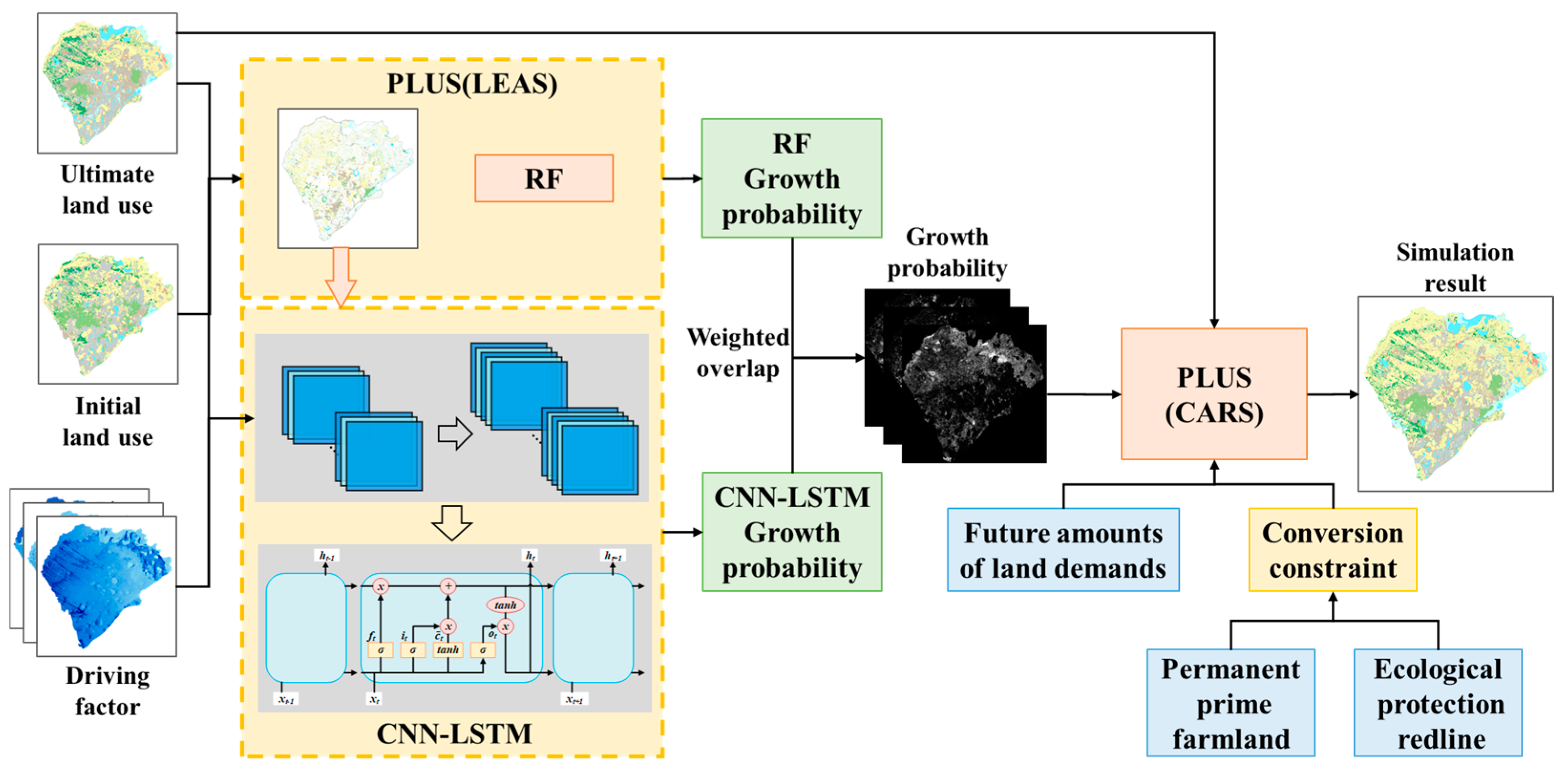
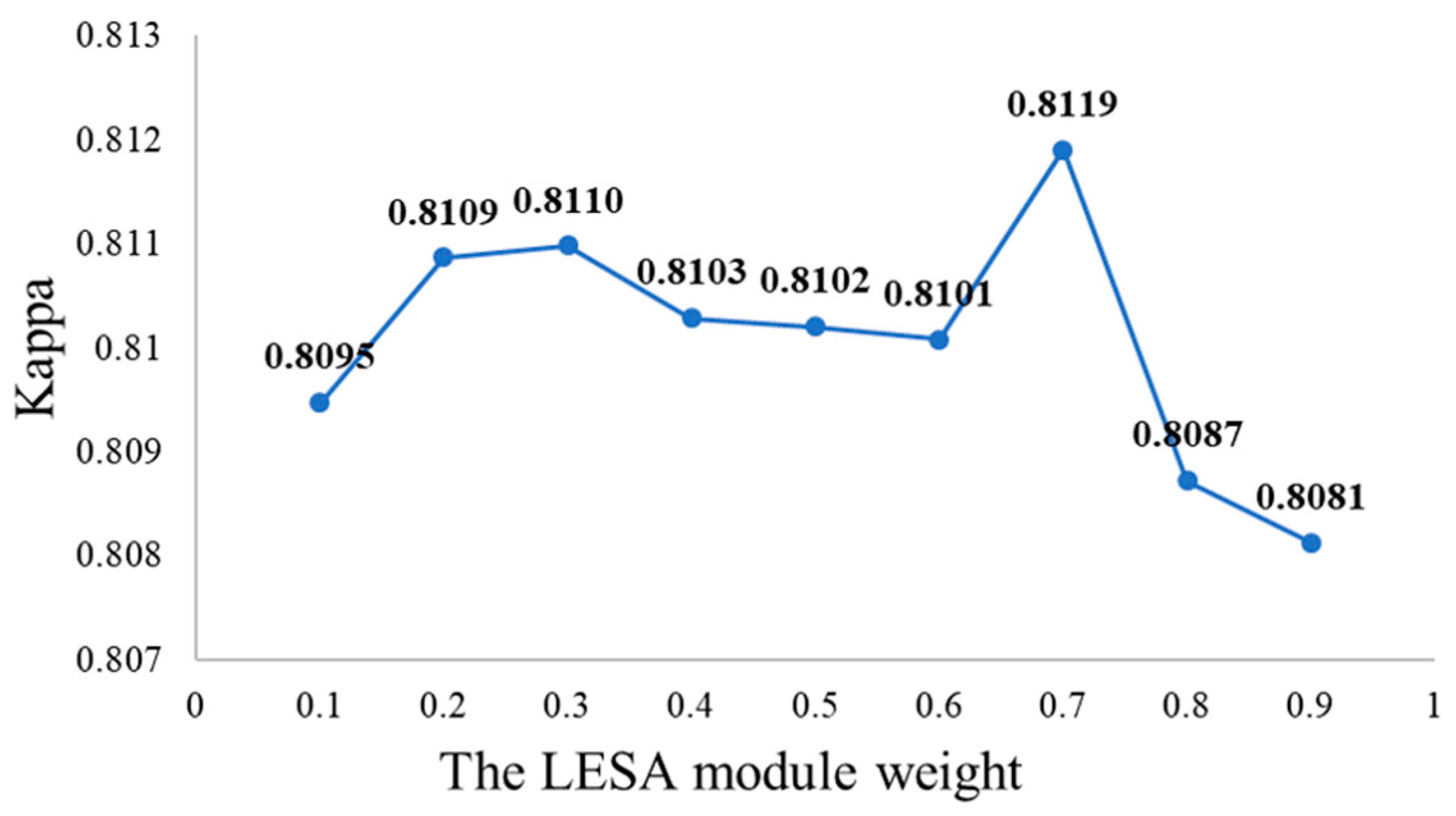
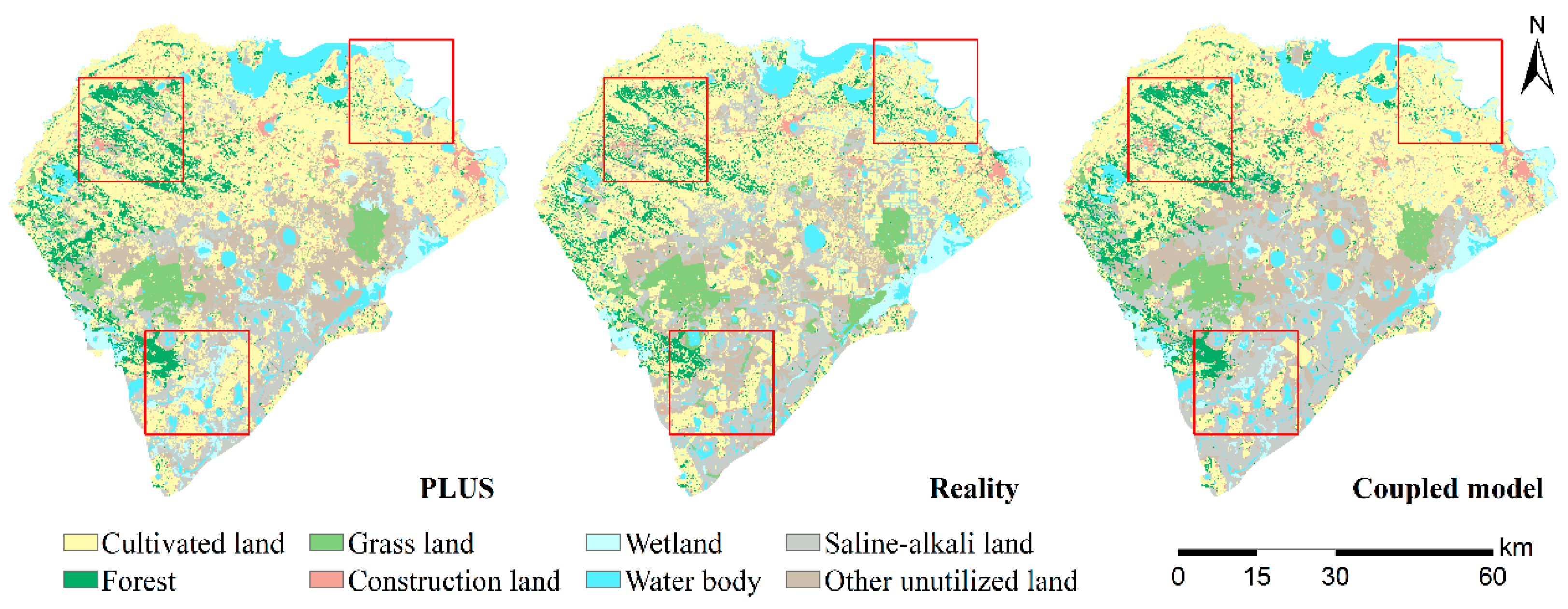
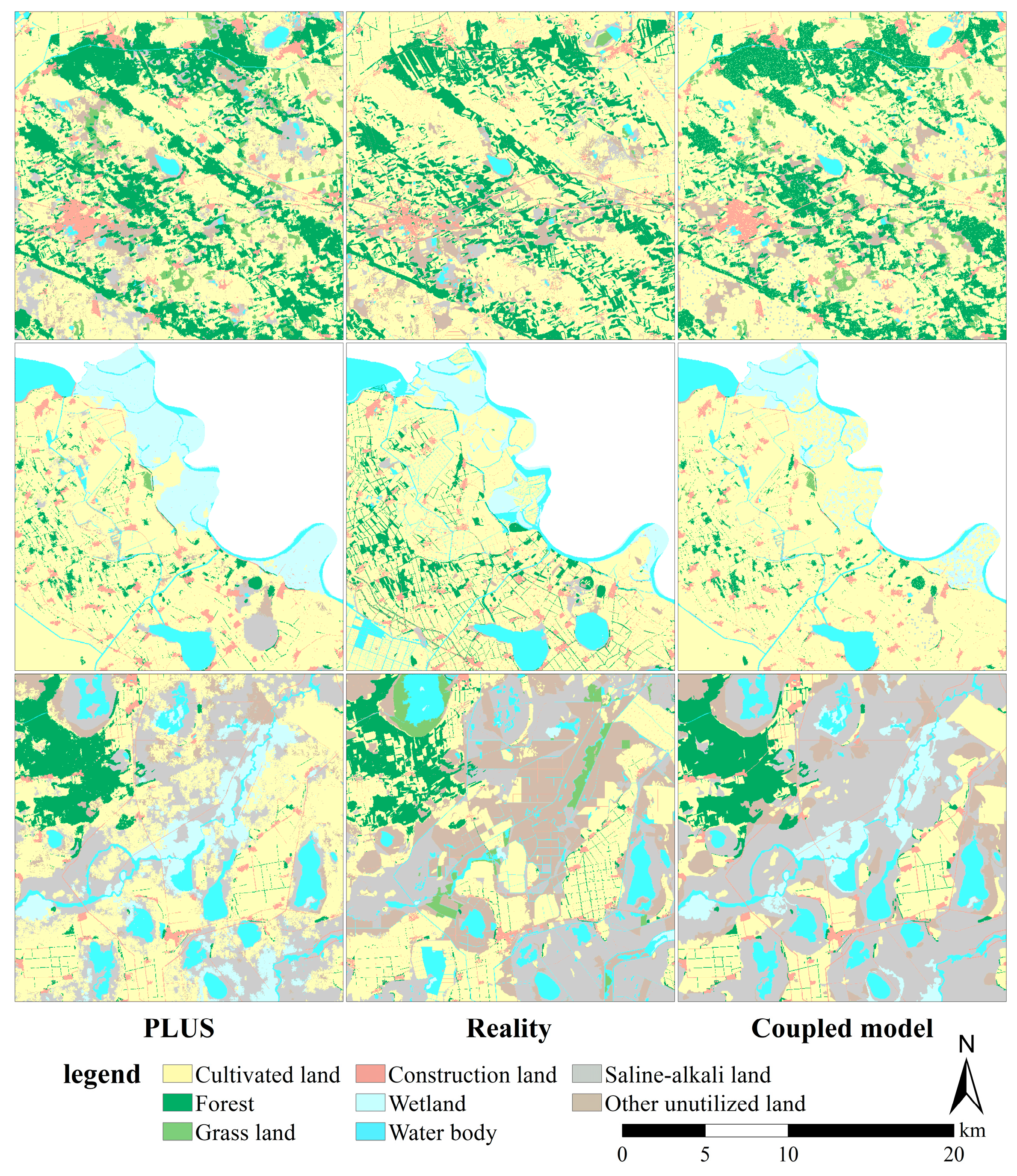

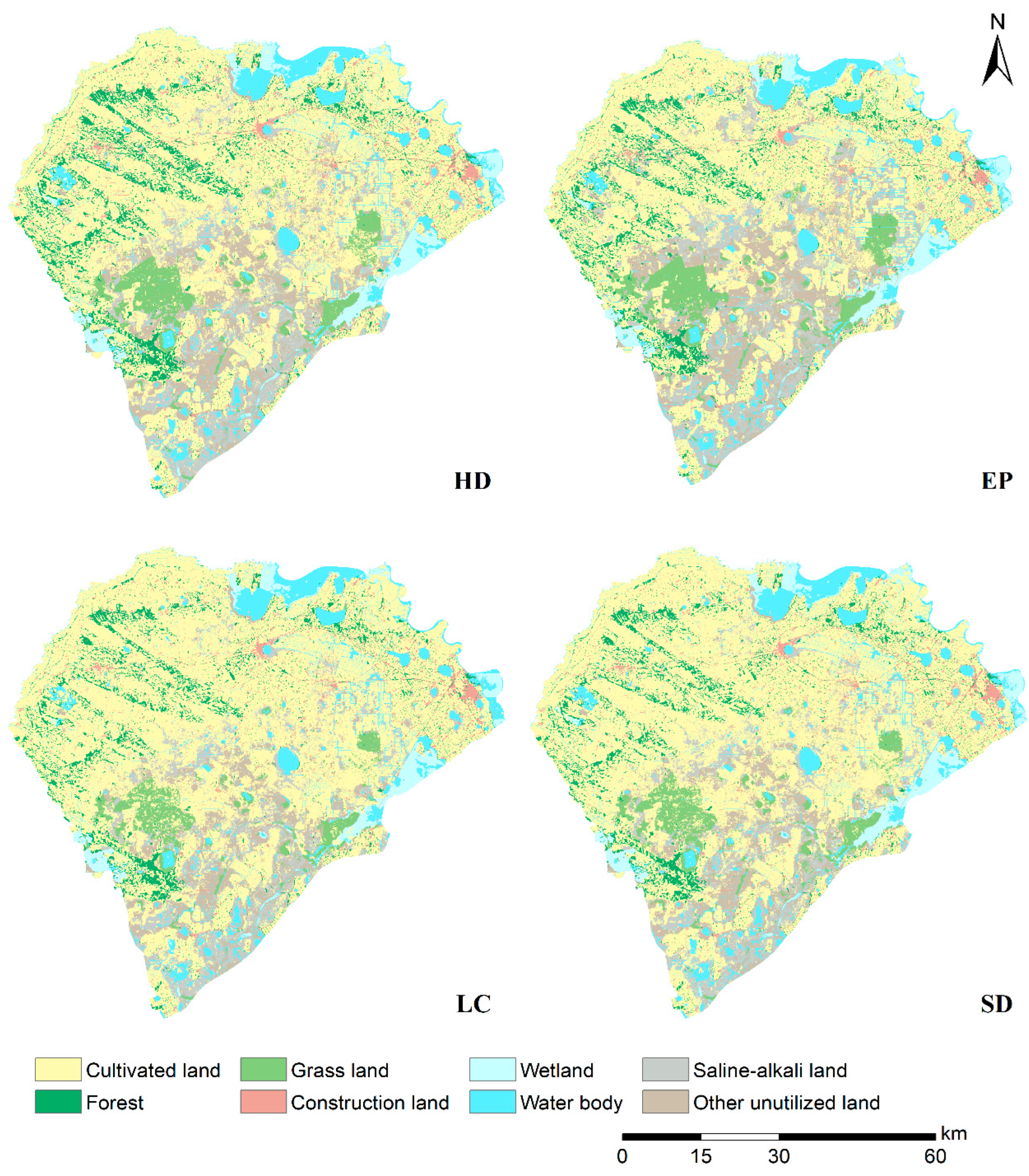
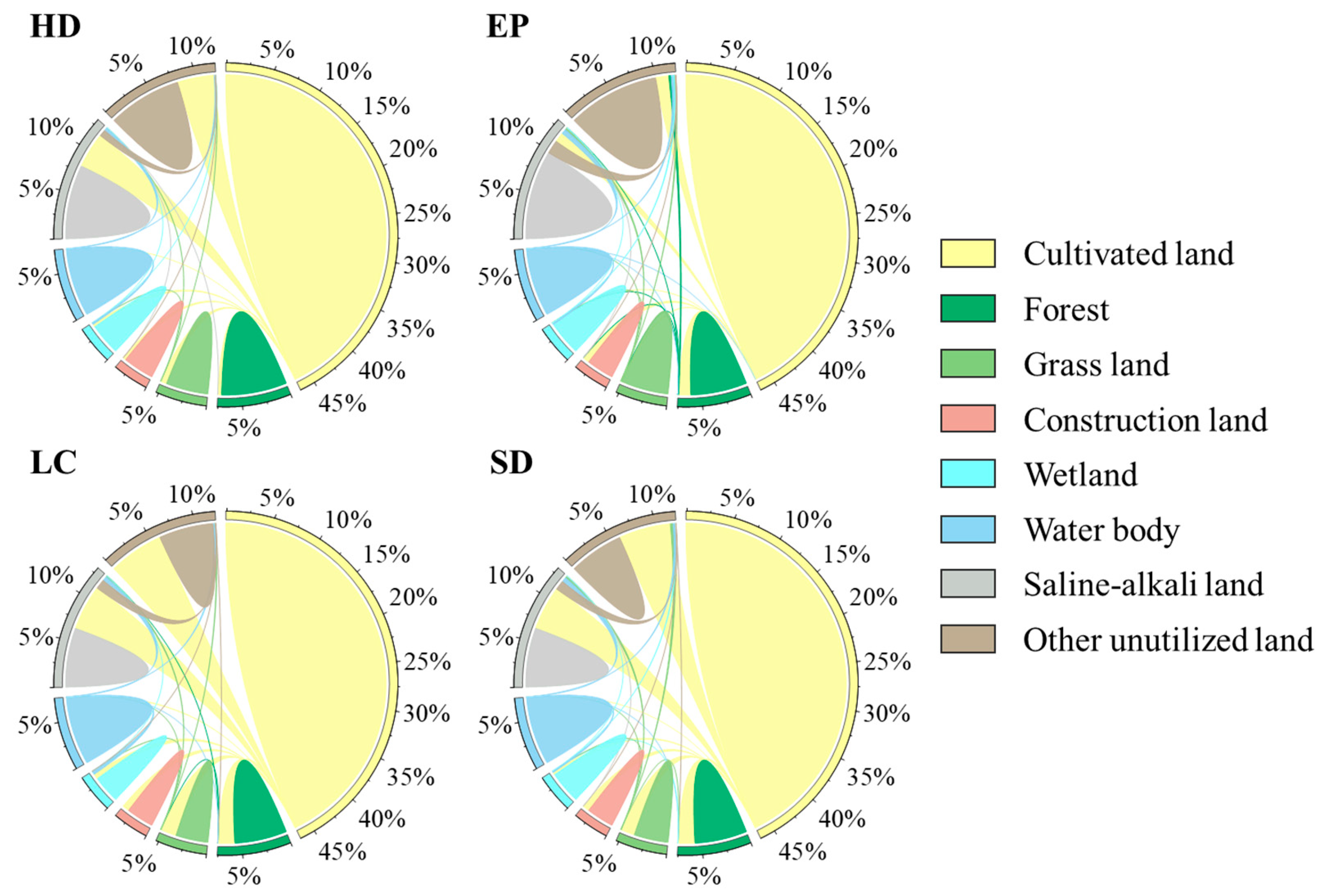
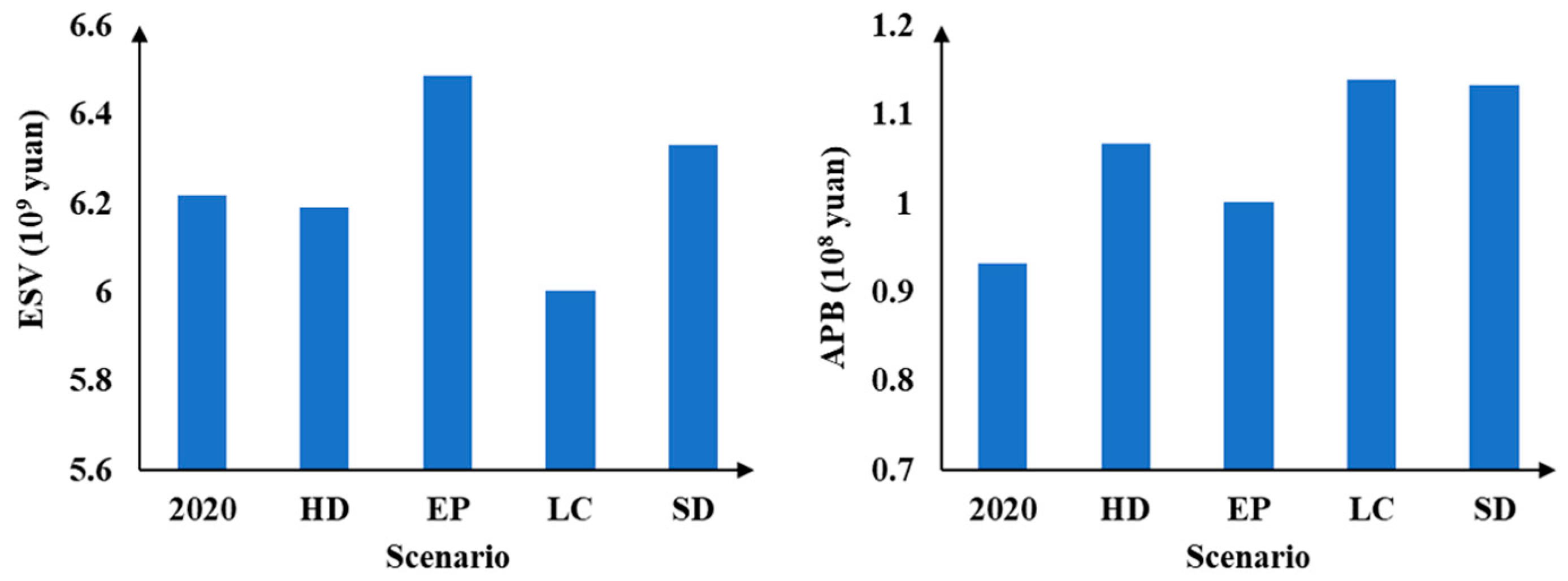
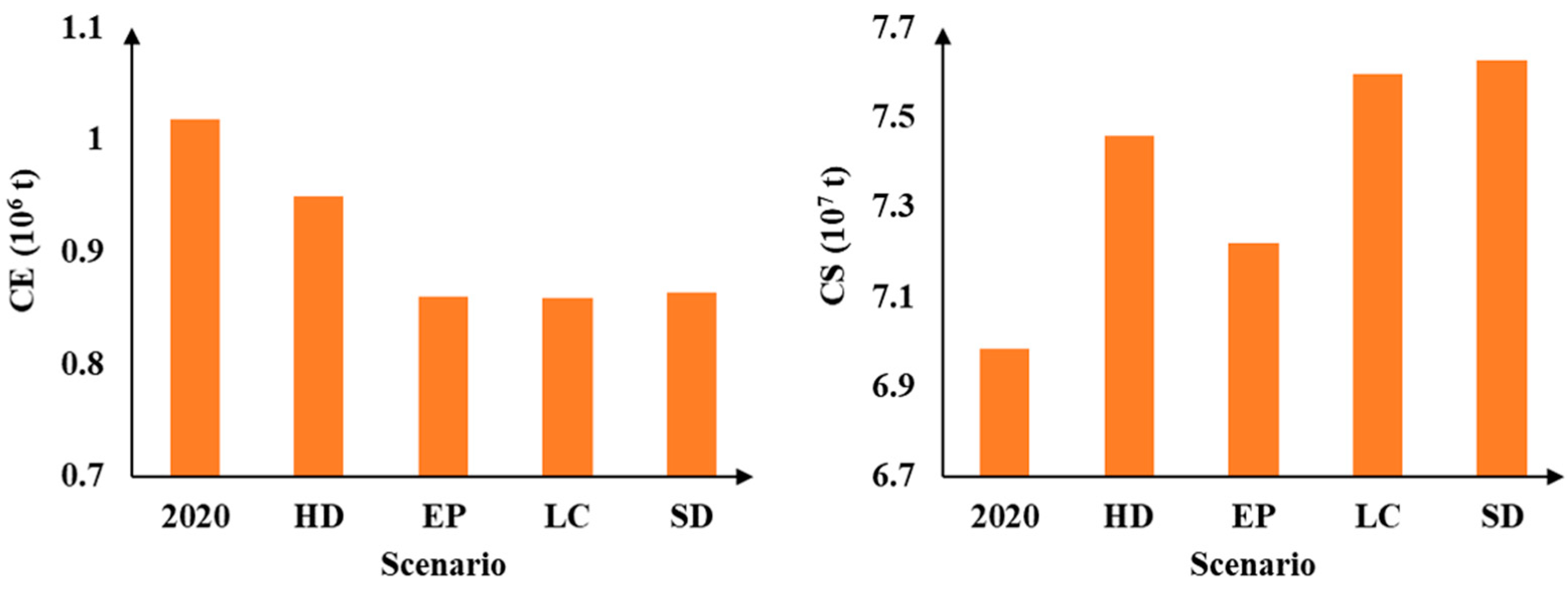
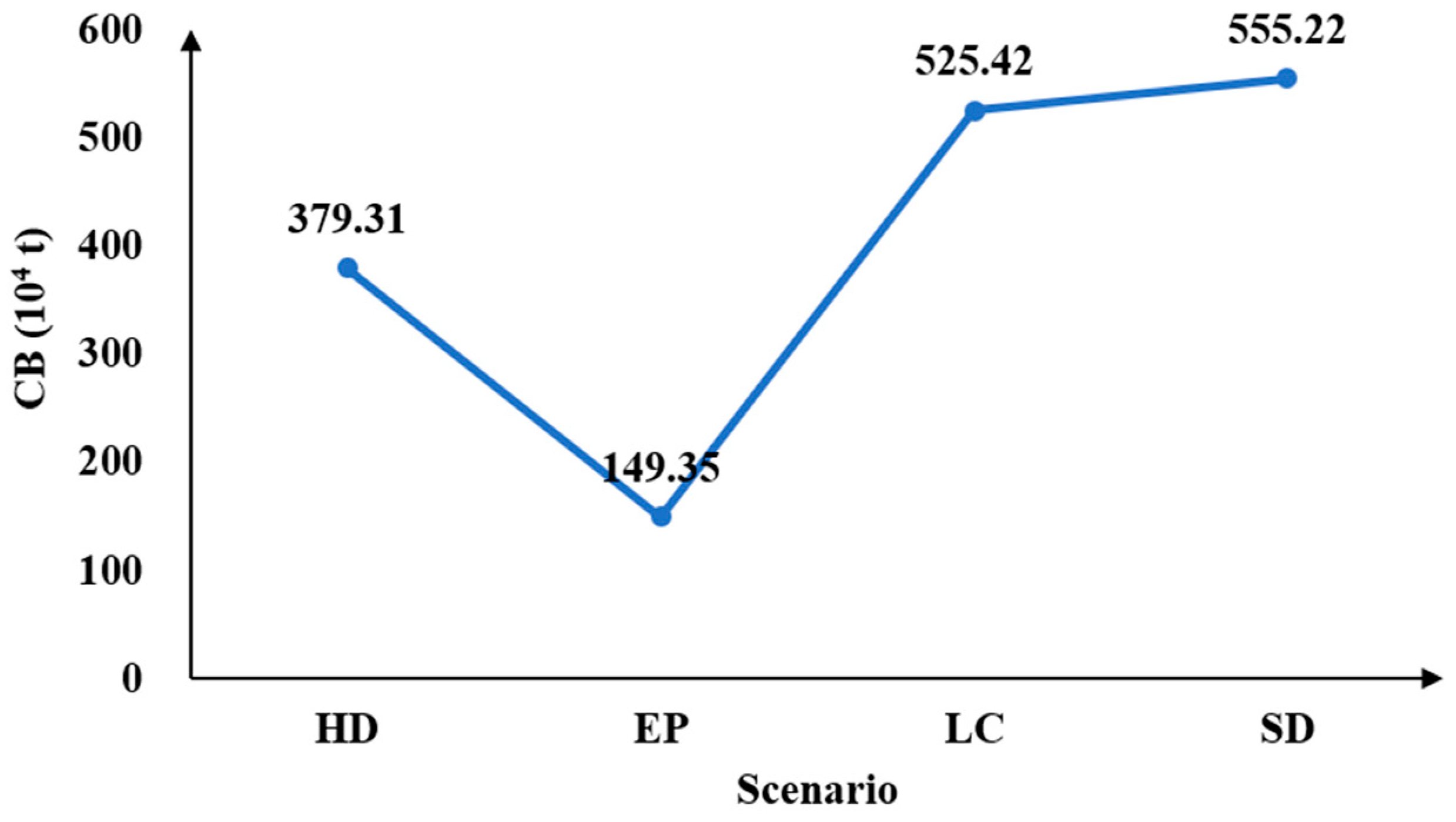
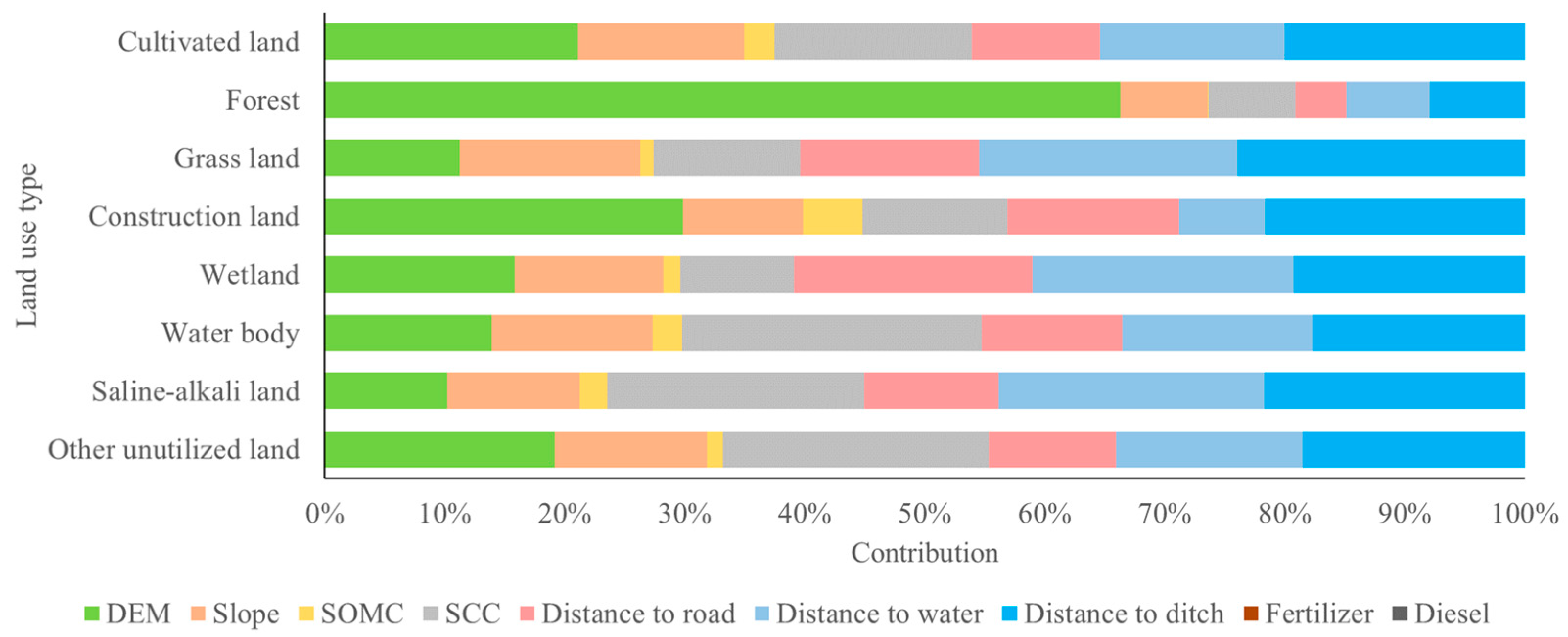
| Land Use Category | Land Use |
|---|---|
| Cultivated land | Cultivated land |
| Forest land | Orchard, Forest |
| Grass land | Grass land |
| Construction land | Urban construction land, transportation land, Industrial mining and storage land |
| Wetland | Wetland |
| Water body | Water body |
| Saline-alkali land | Saline-alkali land |
| Other unutilized land | Weed land, bare land, idle land |
| 250.2 | 810.63 | 800.01 | 0 | 10,991.16 | 6317.37 | 109.35 | 36 | |
| 27.47 | 16.94 | 11.74 | 0 | 20.55 | 20.96 | 0.81 | 0.41 |
| Constraint | Description |
|---|---|
| The sum of the areas of all types is equal to the total area of the study area. | |
) | The cultivated land area is not less than the area of permanent prime farmland in the study area, and not more than 1.2 times the cultivated land area in the HD scenario (under the EP scenarios, a substantial increase in cultivated land will occupy ecological land, so the area of cultivated land is limited to no more than 1.1 times the 2020 level). |
| The total area of forest, grass land, wetlands, water bodies and other unutilized land is not less than the area of the ecological protection redline in the study area. | |
| According to the Master Plan for the Territorial Space of Da’an City (2021–2035), the area of construction land should not be higher than 1.18 times the 2020 level. | |
| According to relevant studies [33,37], and taking into account the actual situation in the study area, the area of each land type should be based on the HD scenario, with a fluctuation range of no more than 20%. |
| 0.030 | 0.002 | 0.157 | 4.257 | 0.065 | 0.065 | 0 | 0 | |
| 13.66 | 20.69 | 13.12 | 13.08 | 26.24 | 26.24 | 3.10 | 3.10 |
| HD | EP | LC | SD | |
|---|---|---|---|---|
| Cultivated land | 2740.31 | 2497.04 | 3046.29 | 2996.24 |
| Forest | 347.42 | 314.09 | 277.94 | 277.94 |
| Grass land | 228.72 | 274.47 | 182.98 | 210.21 |
| Construction land | 164.30 | 144.85 | 144.85 | 144.85 |
| Wetland | 172.04 | 193.79 | 148.92 | 179.21 |
| Water body | 391.41 | 401.69 | 409.16 | 401.69 |
| Saline-alkali land | 399.43 | 479.31 | 319.54 | 319.54 |
| Other unutilized land | 430.32 | 568.70 | 344.26 | 344.26 |
| Total | 4873.94 | 4873.94 | 4873.94 | 4873.94 |
| Scenario | Type | Cultivated Land | Ecological Land | Saline-Alkali Land and Other Unutilized Land |
|---|---|---|---|---|
| HD | Cultivated land | 99.80% | 0.00% | 0.20% |
| Ecological land | 5.87% | 94.09% | 0.04% | |
| Saline-alkali land and other unutilized land | 31.36% | 2.07% | 66.57% | |
| EP | Cultivated land | 99.91% | 0.01% | 0.08% |
| Ecological land | 5.88% | 93.63% | 0.49% | |
| Saline-alkali land and other unutilized land | 10.03% | 5.99% | 83.98% | |
| LC | Cultivated land | 99.81% | 0.00% | 0.19% |
| Ecological land | 17.62% | 82.32% | 0.06% | |
| Saline-alkali land and other unutilized land | 43.25% | 3.57% | 53.17% | |
| SD | Cultivated land | 99.81% | 0.00% | 0.19% |
| Ecological land | 15.24% | 84.69% | 0.07% | |
| Saline-alkali land and other unutilized land | 41.49% | 5.34% | 53.17% |
Disclaimer/Publisher’s Note: The statements, opinions and data contained in all publications are solely those of the individual author(s) and contributor(s) and not of MDPI and/or the editor(s). MDPI and/or the editor(s) disclaim responsibility for any injury to people or property resulting from any ideas, methods, instructions or products referred to in the content. |
© 2025 by the authors. Licensee MDPI, Basel, Switzerland. This article is an open access article distributed under the terms and conditions of the Creative Commons Attribution (CC BY) license (https://creativecommons.org/licenses/by/4.0/).
Share and Cite
Li, S.; Zhang, C.; Chen, C.; Yang, C.; Zhao, L.; Bai, X. Optimization Simulation and Comprehensive Evaluation Coupled with CNN-LSTM and PLUS for Multi-Scenario Land Use in Cultivated Land Reserve Resource Area. Remote Sens. 2025, 17, 1619. https://doi.org/10.3390/rs17091619
Li S, Zhang C, Chen C, Yang C, Zhao L, Bai X. Optimization Simulation and Comprehensive Evaluation Coupled with CNN-LSTM and PLUS for Multi-Scenario Land Use in Cultivated Land Reserve Resource Area. Remote Sensing. 2025; 17(9):1619. https://doi.org/10.3390/rs17091619
Chicago/Turabian StyleLi, Shaner, Chao Zhang, Chang Chen, Cuicui Yang, Lihua Zhao, and Xuechuan Bai. 2025. "Optimization Simulation and Comprehensive Evaluation Coupled with CNN-LSTM and PLUS for Multi-Scenario Land Use in Cultivated Land Reserve Resource Area" Remote Sensing 17, no. 9: 1619. https://doi.org/10.3390/rs17091619
APA StyleLi, S., Zhang, C., Chen, C., Yang, C., Zhao, L., & Bai, X. (2025). Optimization Simulation and Comprehensive Evaluation Coupled with CNN-LSTM and PLUS for Multi-Scenario Land Use in Cultivated Land Reserve Resource Area. Remote Sensing, 17(9), 1619. https://doi.org/10.3390/rs17091619








